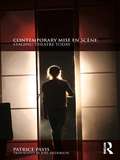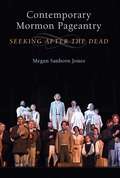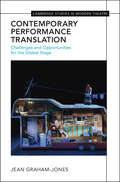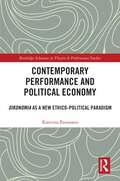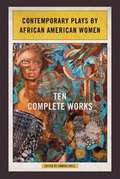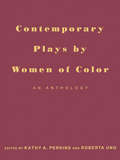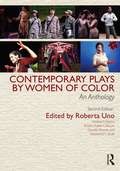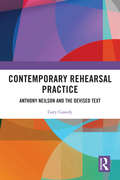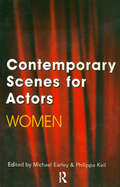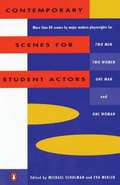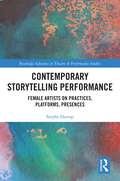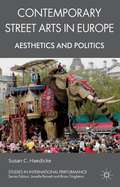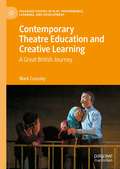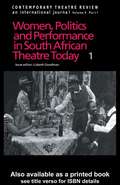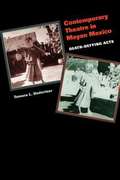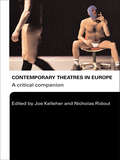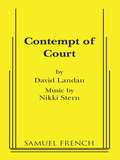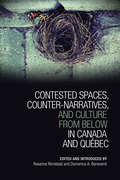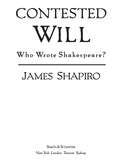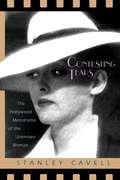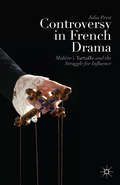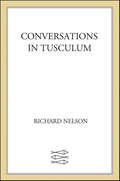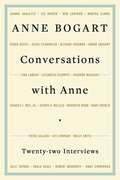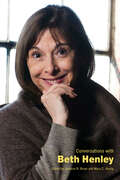- Table View
- List View
Contemporary Mise en Scène: Staging Theatre Today
by Patrice Pavis‘We have good reason to be wary of mise en scène, but that is all the more reason to question this wariness ... it seems that images from a performance come back to haunt us, as if to prolong and transform our experience as spectators, as if to force us to rethink the event, to return to our pleasure or our terror.’ – Patrice Pavis, from the foreword Contemporary Mise en Scène is Patrice Pavis’s masterful analysis of the role that staging has played in the creation and practice of theatre throughout history. This stunningly ambitious study considers: the staged reading, at the frontiers of mise en scène; scenography, which sometimes replaces staging; the reinterpretation of classical and contemporary works; the development of intercultural theatre and ritual; new technologies and their usage live on the stage; the postmodern practice of deconstruction. But it also applies sustained critical attention to the challenges of defining mise en scène, of tracking its development, and of exploring its possible futures. Joel Anderson’s powerful new translation lucidly realises Pavis’s investigation of the changing possibilities for stagecraft in the context of performance art, physical theatre and modern theory.
Contemporary Mormon Pageantry: Seeking After the Dead
by Megan S JonesIn Contemporary Mormon Pageantry, theater scholar Megan Sanborn Jones looks at Mormon pageants, outdoor theatrical productions that celebrate church theology, reenact church history, and bring to life stories from the Book of Mormon. She examines four annual pageants in the United States-the Hill Cumorah Pageant in upstate New York, the Manti Pageant in Utah, the Nauvoo Pageant in Illinois, and the Mesa Easter Pageant in Arizona. The nature and extravagance of the pageants vary by location, with some live orchestras, dancing, and hundreds of costumed performers, mostly local church members. Based on deep historical research and enhanced by the author's interviews with pageant producers and cast members as well as the author's own experiences as a participant-observer, the book reveals the strategies by which these pageants resurrect the Mormon past on stage. Jones analyzes the place of the productions within the American theatrical landscape and draws connections between the Latter-day Saints theology of the redemption of the dead and Mormon pageantry in the three related sites of sacred space, participation, and spectatorship. Using a combination of religious and performance theory, Jones demonstrates that Mormon pageantry is a rich and complex site of engagement between theater, theology, and praxis that explores the saving power of performance.
Contemporary Performance Translation: Challenges and Opportunities for the Global Stage (Cambridge Studies in Modern Theatre)
by Jean Graham-JonesRadically rethinking translation for the contemporary international stage, Jean Graham-Jones interrogates standard linguistic and cultural categories and proposes an overhaul of the translation process itself, incorporating dramaturgical logic and staging, actor training and performance styles, gesture and embodiment, and performance aesthetics and reception. She demonstrates how a theory of translationality – in which translations do not erase the original but rather stand in relation to it and to other texts and performances – encapsulates the collaborative process between contemporary translators and theatre artists. Presenting multiple experiential cases and drawing on Graham-Jones's own career as a translator, actor, director and scholar working in Argentina, the US, and the UK, this richly interdisciplinary work extends a traditional understanding of contemporary performance translation and its potential in theatrical practice.
Contemporary Performance and Political Economy: Oikonomia as a New Ethico-Political Paradigm (Routledge Advances in Theatre & Performance Studies)
by Katerina ParamanaContemporary Performance and Political Economy examines haunting concepts, relations, and artworks that demand our attention. Under capitalism, political and ethical considerations are subordinated to economic ones, and this subordination creates ghost worlds. Performance works, however, can offer insights into alternative politico-economic models. In this major contribution to the fields of contemporary performance and political economy, Katerina Paramana proposes that the investigation of performance works as economies can make the insights performance works offer visible. She positions the examination in relation to contemporary critiques of capitalism, neo-feudalism, and their by-products, and proposes and develops the notion of "oikonomia" as a means to theorize artworks which, through their house (oikos) rules (nomoi), propose ethico-political challenges to the economies in which they are embedded. For this, Paramana looks at politically positioned performance works created and presented in Cuba, Europe, Mexico, the UK, and the US. Her interest is in the politics, ethics, and effects of these works’ "house rules", and the insights they offer to the reconceptualization of political economy. Ultimately, this book aims to transform our understanding of economy’s purpose. It contributes to the development of a new ethico-political paradigm upon which a reconceptualization of political economy can be based. This inspiring study seeks to keep the fire for change alive by demonstrating that political economies, much like performances, are experiments that can be changed.This work will be of great interest to students and scholars in performance studies, theatre, visual cultures, politics, cultural studies, dance, and visual arts, and critical theorists.
Contemporary Physics Plays: Making Time To Know Responsibility (Palgrave Studies in Literature, Science and Medicine)
by Jenni G. HalpinThis book analyzes recent physics plays, arguing that their enaction of concepts from the sciences they discuss alters the nature of the decisions made by the characters, changing the ethical judgements that might be cast on them. Recent physics plays regularly alter the shape of space-time itself, drawing together disparate moments, reversing the flow of time, creating apparent contradictions, and iterating scenes for multiple branches of counterfactual history. With these changes both causality and responsibility shift, variously. The roles of iconic scientists, such as Albert Einstein and Werner Heisenberg, are interrogated for their dramatic value, placing history and dramatic license in tension. Cold War strategies and the limits of espionage highlight the emphatically personal involvement of ordinary individuals. This study is vital reading for those interested in physics plays and the relationship between the sciences and the humanities.
Contemporary Plays by African American Women: Ten Complete Works
by Sandra AdellAfrican American women have increasingly begun to see their plays performed from regional stages to Broadway. Yet many of these artists still struggle to gain attention. In this volume, Sandra Adell draws from the vital wellspring of works created by African American women in the twenty-first century to present ten plays by both prominent and up-and-coming writers. Taken together, the selections portray how these women engage with history as they delve into--and shake up--issues of gender and class to craft compelling stories of African American life. Gliding from gritty urbanism to rural landscapes, these works expand boundaries and boldly disrupt modes of theatrical representation. Selections: Blue Door , by Tanya Barfield; Levee James , by S. M. Shephard-Massat; Hoodoo Love , by Katori Hall; Carnaval , by Nikkole Salter; Single Black Female , by Lisa B. Thompson; Fabulation, or The Re-Education of Undine , by Lynn Nottage; BlackTop Sky , by Christina Anderson; Voyeurs de Venus , by Lydia Diamond; Fedra , by J. Nicole Brooks; and Uppa Creek: A Modern Anachronistic Parody in the Minstrel Tradition , by Keli Garrett.
Contemporary Plays by Women of Color: An Anthology
by Roberta UnoContemporary Plays by Women of Color is a ground-breaking anthology of eighteen new and recent works by African American, Asian American, Latina American and Native American playwrights. This compelling collection includes works by award-winning and well-known playwrights such as Anna Deavere Smith, Cherrie Moraga, Pearl Cleage, Marga Gomez and Spiderwoman, as well as many exciting newcomers. Contemporary Plays by Women of Color is the first anthology to display such an abundance of talent from such a wide range of today's women playwrights. The plays tackle a variety of topics - from the playful to the painful - and represent numerous different approaches to playmaking. The volume also includes: * an invaluable appendix of published plays by women of color * biographical notes on each writer * the production history of each play Contemporary Plays by Women of Color is a unique resource for practitioners, students and lovers of theatre, and an inspiring addition to any bookshelf.
Contemporary Plays by Women of Color: An Anthology
by Roberta UnoIn the two decades since the first edition of Contemporary Plays by Women of Color was published, its significance to the theatrical landscape in the United States has grown exponentially. Work by female writers and writers of color is more widely produced, published, and studied than ever before. Drawing from an exciting range of theaters, large and small, from across the country, Roberta Uno brings together an up-to-date selection of plays from renowned and emerging playwrights tackling a variety of topics. From the playful to the painful, this revised and updated edition presents a rich array of voices, aesthetics, and stories for a transforming America.
Contemporary Rehearsal Practice: Anthony Neilson and the Devised Text
by Gary CassidyThis book provides the first comprehensive study of Anthony Neilson’s unconventional rehearsal methodology. Neilson’s notably collaborative rehearsal process affords an unusual amount of creative input to the actors he works with and has garnered much interest from scholars and practitioners alike. This study analyses material edited from 100 hours of footage of the rehearsals of Neilson’s 2013 play Narrative at the Royal Court Theatre, as well as interviews with Neilson himself, the Narrative cast, and actors from other Neilson productions. Replete with case studies, Gary Cassidy also considers the work of other relevant practitioners where appropriate, such as Katie Mitchell, Forced Entertainment, Joan Littlewood, Peter Brook, Complicite’s Simon McBurney, Stanislavski and Sarah Kane. Contemporary Rehearsal Practice will be of great interest to scholars, students and practitioners of theatre and performance and those who have an interest in rehearsal studies.
Contemporary Scenes for Actors: Women
by Michael Earley Philippa KeilFirst Published in 1999. Routledge is an imprint of Taylor & Francis, an informa company.
Contemporary Scenes for Student Actors
by Michael Schulman Eva MeklerCompiles more than eighty scenes by such modern playwrights as Williams, Slade, Miller, Zindel, and Feiffer for two men, two women, and one man and one woman.
Contemporary Storytelling Performance: Female Artists on Practices, Platforms, Presences (Routledge Advances in Theatre & Performance Studies)
by Stephe HarropThis book focuses on a rising generation of female storytellers, analysing their innovation in interdisciplinary collaboration, and their creation of new multimedia platforms for story-led performance. It draws on an unprecedented series of in-depth interviews with artists including Jo Blake, Xanthe Gresham-Knight, Mara Menzies, Clare Murphy, Debs Newbold, Rachel Rose Reid, Sarah Liisa Wilkinson, and Vanessa Woolf, while Sally Pomme Clayton’s reflections on her extraordinary four-decade career provide long-term context for these cutting-edge conversations. Blending ethnographic research and performance analysis, the book documents the working lives of professional storytelling artists. It sheds light on the practices, values, aspirations, and achievements of a generation actively re-defining storytelling as a contemporary performance practice, taking on topics from ecology and maternity to griefwork and neuroscience, while working collaboratively with diverse creative partners to generate new, inclusive presences for a traditionally-inspired artform. This book will be of great interest to students, scholars, and practitioners in drama, theatre, performance, creative writing, education, and media.
Contemporary Street Arts in Europe
by Susan C. HaedickeStreet theatre invades a public space, shakes it up and disappears, but the memory of the disruption haunts the site for audiences who experience it. This book looks at how the dynamic interrelationship of performance, participant and place creates a politicized aesthetic of public space that enables the public to rehearse democratic practices.
Contemporary Theatre Education and Creative Learning: A Great British Journey (Palgrave Studies In Play, Performance, Learning, and Development)
by Mark CrossleyThis book considers the state of contemporary theatre education in Great Britain is in two parts. The first half considers the national identities of each of the three mainland nations of England, Scotland, and Wales to understand how these differing identities are reflected and refracted through culture, theatre education and creative learning. The second half attends to 21st century theatre education, proposing a more explicit correlation between contemporary theatre and theatre education. It considers how theatre education in the country has arrived at its current state and why it is often marginalised in national discourse. Attention is given to some of the most significant developments in contemporary theatre education across the three nations, reflecting on how such practice is informed by and offers a challenge to conceptions of place and nation. Drawing upon the latest research and strategic thinking in culture and the arts, and providing over thirty interviews and practitioner case studies, this book is infused with a rigorous and detailed analysis of theatre education, and illuminated by the voices and perspectives of innovative theatre practitioners.
Contemporary Theatre Review: Women, Politics and Performance in South African Theatre Today (Contemporary Theatre Review Ser. #Vols. 9, Pts. 1.)
by Lizbeth GoodmanFirst published in 1999, 'Women, Politics and Performance in South African Theatre Today' is an important contribution to Performance.
Contemporary Theatre in Mayan Mexico: Death-Defying Acts
by Tamara L. UnderinerFrom the dramatization of local legends to the staging of plays by Shakespeare and other canonical playwrights to the exploration of contemporary sociopolitical problems and their effects on women and children, Mayan theatre is a flourishing cultural institution in southern Mexico. Part of a larger movement to define Mayan self-identity and reclaim a Mayan cultural heritage, theatre in Mayan languages has both reflected on and contributed to a growing awareness of Mayans as contemporary cultural and political players in Mexico and on the world's stage. In this book, Tamara Underiner draws on fieldwork with theatre groups in Chiapas, Tabasco, and Yucatán to observe the Maya peoples in the process of defining themselves through theatrical performance. She looks at the activities of four theatre groups or networks, focusing on their operating strategies and on close analyses of selected dramatic texts. She shows that while each group works under the rubric of Mayan or indigenous theatre, their works are also in constant dialogue, confrontation, and collaboration with the wider, non-Mayan world. Her observations thus reveal not only how theatre is an agent of cultural self-definition and community-building but also how theatre negotiates complex relations among indigenous communities in Mayan Mexico, state governments, and non-Mayan artists and researchers.
Contemporary Theatres in Europe: A Critical Companion
by Nicholas Ridout Joe KelleherThrough specific examples, case studies and essays by specialist writers, academics, and a new generation of theatre researchers, this collection of specially commissioned essays looks at current theatre practices across Europe. From Théatre du Soleil to Socìetas Raffaello Sanzio, the authors reconsider the possibilities of theatre practice, its relation to history and location and its place in Europe at the turn of the twenty-first century. Contemporary Theatres in Europe examines a wide range of topics including: mainstream European theatre experimental performance music theatre theatre for children dance theatre. Tailor-made for students, offering clear examples of different ways of thinking and writing about performance, this is a richly detailed introduction which brings key themes to life for all students of European theatre.
Contempt of Court
by David LandauFull Length / Interactive Comedy / 3m, 2f / Interior CONTEMPT OF COURT is a new non-mystery interactive comedy from the inventor of the interactive dinner theater. It's a typical night at Judge Judy's Peoples Night court where audience members become plaintiffs, defendants, witnesses and jury in some of the most outlandishly funny law suits ever to double cross the bench. This hilarious comedy send up of all those TV court shows proves that some people really have a Contempt of Court.
Contested Spaces, Counter-narratives, and Culture from Below in Canada and Québec
by Roxanne Rimstead Domenic A. BeneventiThis collection explores strategies of reading space and conflict in Canadian and Québécois literary and cultural performances. How do literary texts and popular cultural performances produce and contest spatial practices? What is the role of the nation, the city, the community, and the individual subject in reproducing space, even during times of global hegemony and neocolonialism? In what ways do marginalized individuals and communities represent, contest, or appropriate spaces through counter-narratives and expressions of culture from below? And how does space itself shape conflict, counter-memory, and culture from below? Focusing on contestation instead of harmony and consensus, Contested Spaces disturbs the idealized space of Canadian multicultural pluralism to carry literary analysis and cultural studies into spaces often undetected and unforeseen; Contested Spaces exposes geographies of exclusion and difference such as flophouses and "slums," shantytowns and urban alleyways, underground spaces and peep shows, inner city urban parks as experienced by minority ethnics, the poor, women, social activists, Indigenous people, and Francophones in Canada. These essays are the product of sustained and high-level collaboration across French and English academic communities in Canada to facilitate theoretical exchange on the topic of space and contestation, to expose geographies of exclusion, and to generate new spaces of hope in the spirit of pioneering work by Henri Lefebvre, Michel Foucault, Michel de Certeau, Doreen Massey, David Harvey, and other more recent theorists of space.
Contested Will: Who Wrote Shakespeare?
by James ShapiroFor more than two hundred years after William Shakespeare's death, no one doubted that he had written his plays. Since then, however, dozens of candidates have been proposed for the authorship of what is generally agreed to be the finest body of work by a writer in the English language. In this remarkable book, Shakespeare scholar James Shapiro explains when and why so many people began to question whether Shakespeare wrote his plays. Among the doubters have been such writers and thinkers as Sigmund Freud, Henry James, Mark Twain, and Helen Keller. It is a fascinating story, replete with forgeries, deception, false claimants, ciphers and codes, conspiracy theories--and a stunning failure to grasp the power of the imagination. As Contested Will makes clear, much more than proper attribution of Shakespeare's plays is at stake in this authorship controversy. Underlying the arguments over whether Christopher Marlowe, Francis Bacon, or the Earl of Oxford wrote Shakespeare's plays are fundamental questions about literary genius, specifically about the relationship of life and art. Are the plays (and poems) of Shakespeare a sort of hidden autobiography? Do Hamlet, Macbeth, and the other great plays somehow reveal who wrote them? Shapiro is the first Shakespeare scholar to examine the authorship controversy and its history in this way, explaining what it means, why it matters, and how it has persisted despite abundant evidence that William Shakespeare of Stratford wrote the plays attributed to him. This is a brilliant historical investigation that will delight anyone interested in Shakespeare and the literary imagination.
Contesting Tears: The Hollywood Melodrama of the Unknown Woman
by Stanley CavellWhat is marriage? Can a relationship dedicated to equality, friendship, and mutual education flower in an atmosphere of romance? What are the paths between loving another and knowing another? Stanley Cavell identified a genre of classic American films that engaged these questions in his study of comedies of remarriage, Pursuits of Happiness. With Contesting Tears, Cavell demonstrates that a contrasting genre, which he calls "the melodrama of the unknown woman," shares a surprising number and weave of concerns with those comedies. Cavell provides close readings of four melodramas he finds definitive of the genre: Letter from an Unknown Woman, Gaslight, Now Voyager, and Stella Dallas. The women in these melodramas, like the women in the comedies, demand equality, shared education, and transfiguration, exemplifying for Cavell a moral perfectionism he identifies as Emersonian. But unlike the comedies, which portray a quest for a shared existence of expressiveness and joy, the melodramas trace instead the woman's recognition that in this quest she is isolated. Part of the melodrama concerns the various ways the men in the films (and the audiences of the films) interpret and desire to force the woman's consequent inaccessibility. "Film is an interest of mine," Stanley Cavell has written, "or say a love, not separate from my interest in, or love of, philosophy. " In Contesting Tears Cavell once again brilliantly unites his two loves, using detailed and perceptive musings on melodrama to reflect on philosophical problems of skepticism, psychoanalysis, and perfectionism. As he shows, the fascination and intelligence of such great stars as Ingrid Bergman, Bette Davis, and Barbara Stanwyck illuminate, as they are illuminated by, the topics and events of these beloved and enduring films.
Controversy in French Drama: Molière’s Tartuffe and the Struggle for Influence
by Julia PrestIn 1664, Molière's Tartuffe was banned from public performance. This book provides a detailed, in-depth account of five-year struggle (1664-69) to have the ban lifted and, so doing, sheds important new light on 1660s France and the ancien régime more broadly.
Conversations in Tusculum: A Play
by Richard NelsonA riveting new work about power—and the abuse of power— in ancient Rome that has startling resonance with our age, Conversations in Tusculum reimagines the intense interaction among Brutus, Cassius, and Cicero leading up to the assassination of Julius Caesar, the leader they had once followed into battle but whom they have come to despise. Passionate in their beliefs but torn by their sense of loyalty, they struggle to continue believing in him despite their fear that his actions may pose great dangers to the nation. Conversations in Tusculum had its world premiere at the Public Theater in New York City in March 2008."Nelson…is a master of the quiet detail, of the oblique rhythm that transforms emotional diffidence into fascinating character."--Newsday
Conversations with Anne
by Anne BogartFrom one remarkable mind to another, Conversations with Anne documents the series of intimate interviews that theater director Anne Bogart has conducted-before live audiences-with major artists and cultural thinkers at her West Side studio over half a decade. In these extraordinary conversations, Bogart and her guests consider such free-ranging topics as the driving forces in their work, the paths their lives have taken, and their visions for the future of their field. Bogart delves into the daily thoughts of these artists and thinkers whom she most admires-a group that, collectively, has profoundly shaped the arts and artistry in America over the past twenty-five years.Interviewees include: JoAnne Akalaitis, Lee Breuer, Ben Cameron, Martha Clarke, Oskar Eustis, Zelda Fichandler, Richard Foreman, Andre Gregory, Bill T. Jones, Tony Kushner, Tina Landau, Elizabeth LeCompte, Eduardo Machado, Charles Mee, Joseph V. Melillo, Meredith Monk, Peter Sellars, Molly Smith, Elizabeth Streb, Julie Taymor, and Paula Vogel.Anne Bogart is artistic director of the SITI Company, which she founded with Japanese director Tadashi Suzuki in 1992. She has received two OBIE Awards, a Bessie Award, and a Guggenheim Fellowship, and is a professor at Columbia University, where she runs the Graduate Directing Program.
Conversations with Beth Henley (Literary Conversations Series)
by Jackson R. Bryer and Mary C. HartigWith roots in the American South, Beth Henley (b. 1952) has for four decades been a working playwright and screenwriter. Winner of the Pulitzer Prize in 1981 at the age of twenty-eight, Henley so far has written twenty-five produced plays that are always original, usually darkly comic, and often experimental. In these interviews, Henley speaks of the plays, from her early crowd-pleasers, Crimes of the Heart and The Miss Firecracker Contest, to her more experimental plays, including The Debutante Ball and Control Freaks, to her brilliant and time-bending play, The Jacksonian. Henley is a master at writing about the duality of human experience—the beautiful and the grotesque, the cruel and the loving. This duality provokes in Henley both amazement and compassion. She discusses here not only her admiration for Chekhov and other influences, but also her process of bringing a play from notebooks of images and bits of dialogues through rumination, writing, and rewriting to rehearsals and previews. The interviews range from 1981, just before she won the Pulitzer Prize, to 2020 and cover nearly forty years of a creative life, which, as Henley remarks in the most recent interview, is “such a life worth living: to be in tune with the creative process.”
